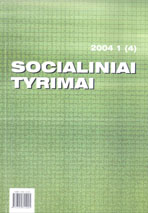Netolygios regionų plėtros analizė
Analysis of Divergent Regional Development
Author(s): Diana Cibulskienė, Mindaugas Butkus, Violeta DamašienėSubject(s): Economy
Published by: VšĮ Šiaulių universiteto leidykla
Keywords: Regional convergence; regional divergence; interregional disparities.
Summary/Abstract: Under conditions of reform, the socio-economic situation of separate region in Lithuania has appeared to fall under the influence of a set of new factors. These include: the rate and scale of economic transformations; the development of market sectors; geographical position; foreign economic co-operation; the mutual relationship of each separate region with the Central Government; and ability to adapt to new conditions and to make good use of them. All these factors have promoted the growth of regional differentiation. The researchers therefore aim to analyse the processes occurring in the given sphere, by estimating the basic parameters of the process of inter-regional stratification and also by determining the major factors forming its dynamics. We have carried out an estimation of the process of differentiation using four parameters: per capita gross regional product; per capita production of regional industry; per capita regional export; and per capita FDI in separate region. The most widespread method of the measurement of the size of regional differentiation is the variance factor also the Gini coefficient is widely used. A class of indices of generalised entropy is less popular, though it has a number of desirable properties: for example, unlike the Gini coefficient, it is sensitive to moving from the bottom part of the distribution to the top. Close in character to entropy factors is the Teil coefficient, also used for inter-regional comparisons. Investigation of the scope of regional convergence and factors predetermining them can present such conclusions: 1. Annually increasing curvature of Lorenz curve illustrates the growing gap between the regions based on GDP for one resident. It must be noted that increasing divergence between the regions is uneven. It significantly correlates with the economic cycles. 2. Industrial development in the Lithuanian regions goes also on unevenly. Largest turnover in the industrial production is observed in Kaunas, Telsiai and Vilnius regions. 3. Direct foreign investments concentrate in three regions; the rest Lithuanian regions, because of insufficient economic development and capital stagnation seem unattractive for the investors. While analysing influence of the investments upon the regional development, one must assess the ration of investments into physical and into human capital. Currently it is very complicated to establish, because the funds, used for staff training and qualification rising are attached to the working expenditures. 4. Basing upon analysis of the regional divergence indices according to the exported industrial production, one can say larger differentiation changes are going on in the advancing and in the lacking region groups. Factor analysis shows that the decisive influence in this trend is made by the part of exported industrial production in the total export volume.
Journal: Socialiniai tyrimai
- Issue Year: 2004
- Issue No: 4
- Page Range: 23-38
- Page Count: 16
- Language: Lithuanian

